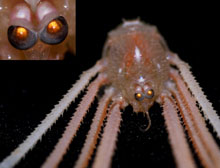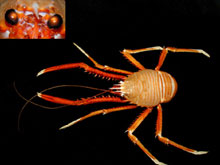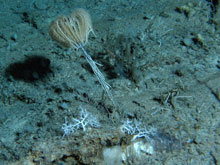
A tall sea lily, Endoxocrinus prionodes, with its arms collapsed under slack current. Click image for larger view and image credit.
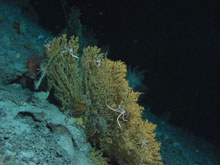
Gerardia corals. Click image for larger view and image credit.
Mission Summary
July 20 – 30, 2009
Tamara Frank
Expedition Chief Scientist
Harbor Branch Oceanographic Institution/Florida Atlantic University
The Bioluminescence 2009 mission was remarkably successful, considering it was only 10 days long. The accomplishments we made on this expedition include:
1) The discovery of three new species and possibly one new genus of crinoids. Crinoids are sea lilies, and are in the same phylum as sea urchins and sea stars. However, as opposed to sea stars and urchins, crinoids are sessile (attached to the bottom). One of the new species belongs to a family that was previously unknown from the western Atlantic Ocean.
2) The discovery of bioluminescence in 14 benthic (bottom dwelling) species out of about 100 species tested. We were actually surprised at how few of the species were bioluminescent; we had expected to find a lot more bioluminescence. Bioluminescent species included the golden coral Gerardia (the large and dominant coral of the lithoherm site), 2 species of anemone (including one that lives on a hermit crab), 3 species of sea pen, 5 species of bamboo coral, and 1 sea cucumber.
In addition, we got some extraordinary color photos of the shrimps Parapandalus and Heterocarpus spewing bioluminescent fluid. Surprisingly, no non-bamboo corals and none of the many species of brittle stars we tested produced light. Because there are a number of shallow brittle stars that are bioluminescent, we were expecting more of the deep-sea brittle stars to be bioluminescent as well.
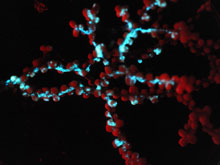
This photograph (taken in the lab) shows the blue-green bioluminescence of the zoantharian Gerardia sp., the dominant species of the lithoherm site we explored. Click image for larger view and image credit.
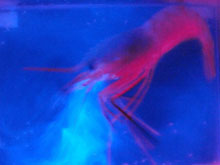
A Caridean shrimp, Parapandalus sp., enveloped in bioluminescent spew emitted during an escape response. The image was taken in lab. Click image for larger view and image credit.
4) The creation of a set of high quality color images of bioluminescence, and the first-ever in situ color images of deep-sea bioluminescence. The commercially available Nikon D700 turned out to perform even better than expected. We were able to obtain color images of animals by the light of their bioluminescence alone.
5) Confirmation of an ultraviolet- (UV)-sensitive visual pigment in addition to a blue-sensitive visual pigment in the deep-sea crab Gastroptychus spinifer (shown below), and discovery of a UV-sensitive visual pigment in another species, Eumunida picta (shown below). These UV-visual pigments give these deep-sea crabs the ability to see UV light, which is a color that we ourselves can’t see. At these depths, there is no UV light remaining from sunlight, so the crabs must be adapted to seeing bioluminescence, although they themselves are not bioluminescent. In addition, we found that the Caridean shrimp which spew bioluminescence, Heterocarpus ensifer and Plesionika ensus, possess a single blue-sensitive visual pigment.
The relative rarity of bioluminescence in benthic species is fascinating and deserves more study. As we noted in our proposal, and confirmed on this expedition, deep-sea benthic animals often have shockingly large eyes, despite being in habitats with almost no solar light. Bioluminescence must play a key role here, but the seeming rarity of benthic bioluminescence in the species we collected seems puzzling. However, we observed some bioluminescence that could not be attributed to any of the nonmotile (unable to move) animals visible when the lights were turned on, suggesting that tiny animals that live below the sediment, called infauna, which were not sampled on this expedition, may be a significant source of some of the bioluminescence that we saw.
In addition, in the high current region of the Little Bahama Bank lithoherms, planktonic animals striking the coral and zooanthid trees provided another source of “benthic” bioluminescence. As clearly seen in one of our photographs, the light from benthic bioluminescent organisms is greener than the light from the planktonic organisms striking them. Is this because the benthic animals are attempting to distinguish themselves from planktonic ones by color? Is this related to the question of why some species of deep-sea crustaceans possess UV sensitivity, while others do not?
These are exciting questions, and ones we may be able to answer as we continue our explorations.
Sign up for the Ocean Explorer E-mail Update List.





















